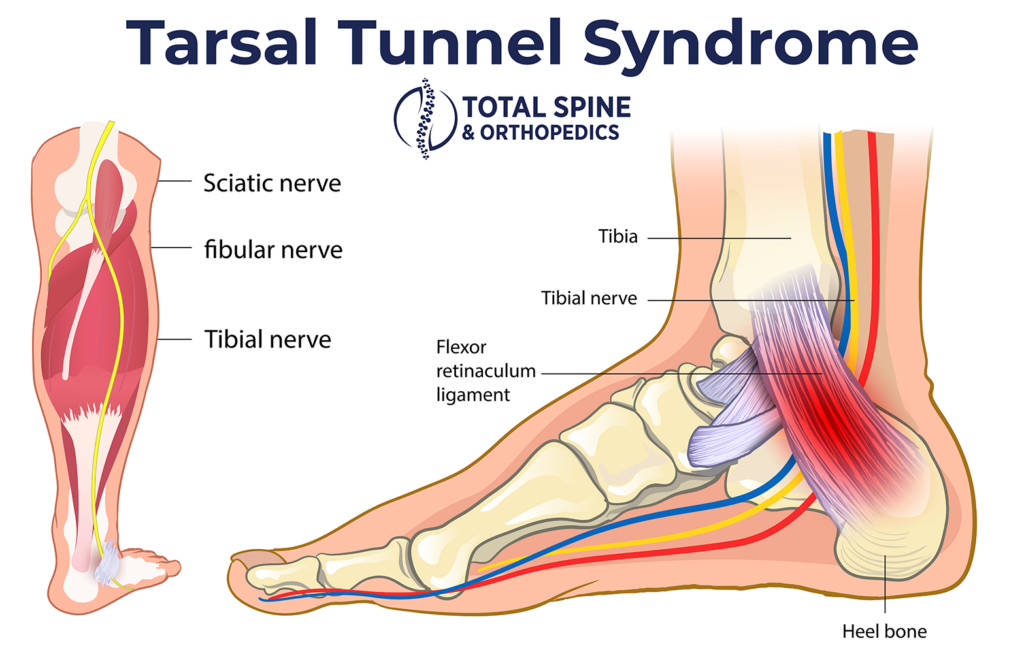What is Tarsal Tunnel Syndrome?
Tarsal tunnel syndrome happens when the tibial nerve is compressed as it passes through the narrow “tarsal tunnel” on the inside of the ankle. Patients often report burning or tingling in the sole, numbness in the toes, and sharp, electric pains that worsen with standing or walking. If bracing, activity changes, or medications no longer help, a tarsal tunnel release may be recommended to free the nerve and restore space.
Why a minimally invasive approach?
At Total Spine and Orthopedics, our goal is to decompress the nerve with the least tissue disruption possible, which typically means:
- Smaller incisions and gentle tissue handling
- Outpatient surgery (go home the same day)
- Lower postoperative discomfort and fewer wound issues
- Earlier return to comfortable walking
Minimally invasive techniques including endoscopic tarsal tunnel release in select cases can reduce scar formation around the nerve and shorten rehabilitation compared with traditional open approaches.
Who is a good candidate?
You may be a candidate if you have:
- Persistent symptoms (numbness, tingling, burning, shooting pain) along the arch/sole
- Exam findings consistent with tibial nerve irritation (e.g., positive Tinel’s over the tunnel)
- Imaging or nerve tests (when appropriate) supporting compression: ultrasound, MRI, or nerve conduction/EMG
- Limited relief after conservative care such as activity changes, custom orthotics, NSAIDs, physical therapy, night splints, or ultrasound-guided steroid injections
Your surgeon will also rule out other causes of foot pain like plantar fasciitis, Morton’s neuroma, lumbar radiculopathy/sciatica, or diabetic neuropathy to ensure surgery targets the true problem.
How the procedure works
A tarsal tunnel release procedure involves creating more space for the tibial nerve and its branches by releasing tight structures such as the flexor retinaculum and addressing any compressive tissue.
What to expect:
- Anesthesia: Local with sedation or light general anesthesia, depending on your case.
- Small incision(s): On the inside of the ankle; some candidates qualify for endoscopic or limited-incision techniques.
- Targeted decompression: The surgeon releases the retinaculum and carefully frees the nerve and branches.
- Closure & dressing: A soft dressing or boot is applied for protection and comfort.
- Same-day discharge: Most patients go home the same day.
What to Expect
Potential and expected benefits
- Relief of numbness, tingling, and burning pain
- Better standing and walking tolerance
- Smaller incisions and typically quicker recovery with minimally invasive techniques
Potential risks (uncommon but important to know)
- Persistent or recurrent symptoms, wound problems, nerve irritation, scar sensitivity, infection, blood clots
- Need for additional procedures if there are multiple compression sites or significant scarring
Our team emphasizes clear communication and stellar postoperative care help minimize risks and get you out of pain!
Nonsurgical & adjunct options
Before or alongside surgery, many patients benefit from:
- Activity modification and footwear changes
- Custom orthotics to improve foot mechanics
- Physical therapy for mobility and nerve glides
- Anti-inflammatory medications (as appropriate)
- Ultrasound-guided injections for targeted anti-inflammatory relief
- Night splints to reduce traction on the nerve during sleep
Frequently asked questions
Is endoscopic release right for everyone?
Not always. Endoscopic or limited-incision methods depend on anatomy, severity, and the presence of space-occupying lesions (like cysts or varicosities). Your surgeon will recommend the least invasive option that still fully decompresses the nerve.
How soon can I walk?
Most patients bear weight the same day in a protective boot or shoe, then gradually increase walking as comfort allows.
Will I need physical therapy?
Usually yes. Physical therapy is typically used to help support nerve mobility, reduce stiffness, and restore normal gait.
How is tarsal tunnel different from plantar fasciitis?
Plantar fasciitis causes heel pain that is worst with first steps in the morning. Tarsal tunnel more often causes tingling, numbness, and burning along the arch/sole and can radiate to the toes.
When to see a specialist
If your foot symptoms have persisted for 6+ weeks despite good footwear, orthotics, and activity changes—or if tingling and numbness are affecting daily life—consider a visit with a foot & ankle specialist. Our orthopedic and podiatric specialists can help get you out of pain and back to living life. You can request an appointment by calling (321) 499-4646 or by filling out the form on this page.


